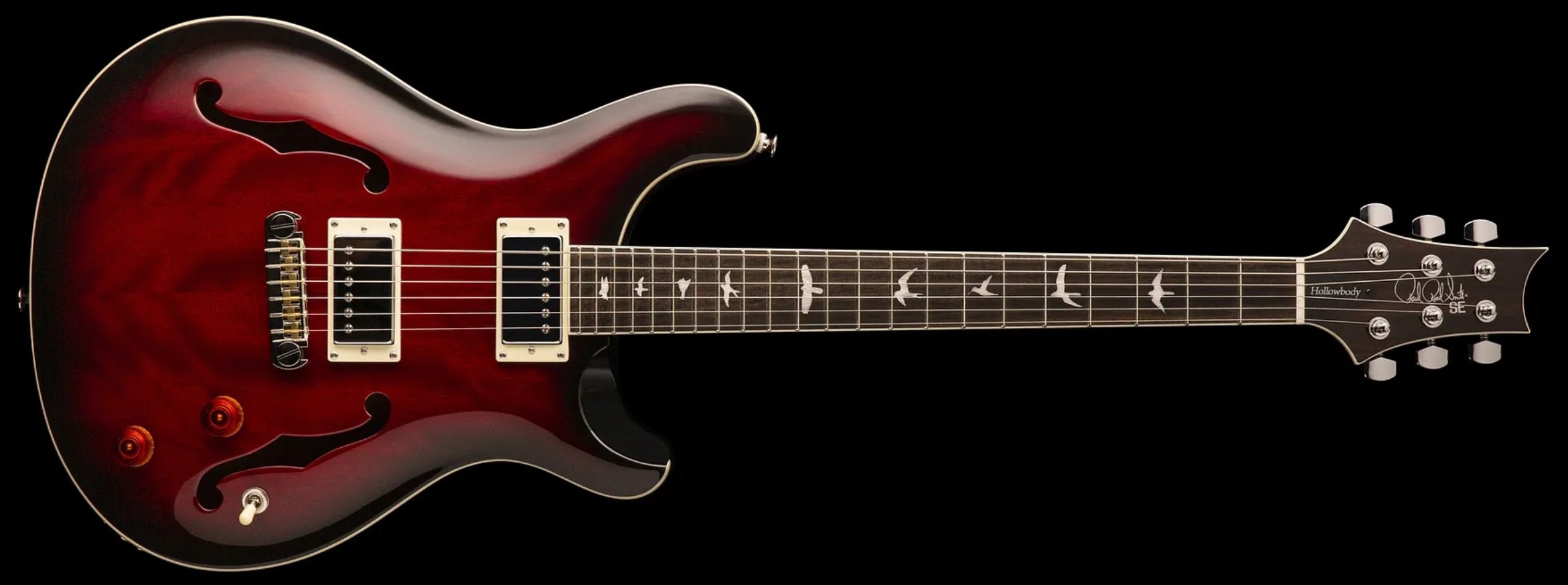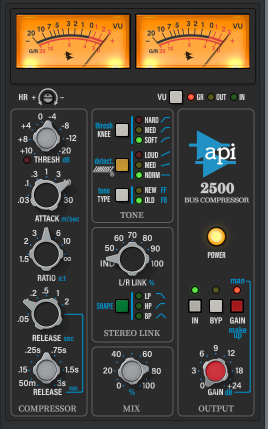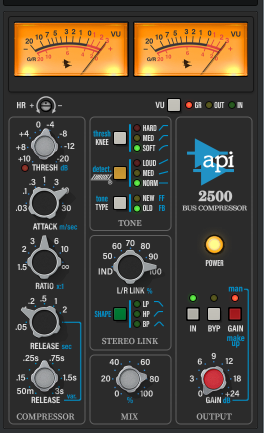Review : PRS SE Hollowbody Standard
It’s my opinion that the already very good PRS SE models built at the dedicated PRS factory operated by Car-Tek in Indonesia have gotten better over the last few years. Regular readers will have seen the very positive reviews of SE guitars posted in the last nine months as concrete examples. This time, with the support of The Arts Music Store, I have obtained an SE Hollowbody Standard for evaluation.
Introduction
The PRS SE Hollowbody Standard is a semi-hollow guitar with two humbucking pickups and one each of volume and tone control. The selection options are simple, neck, neck with bridge and neck. It has a stop tail tailpiece. While shaped like a common PRS, because of its design, think ES-335 or similar. The MAP on this guitar is $1,389 CAD and it includes a very nice hardshell case.
Specifications
I have screen captured the specifications for the current release from the PRS website. The 2024 model is available in Fire Red Burst, which is what is shown in the images. In real life, it’s a very deep red. In the 2024 models, there is no maple veneer cap. There are still 2023 models in stores that have that option.
Impressions and Playability
As is often found with guitars of this type, the mahogany top, back and sides are laminates. This provides rigidity and solid reflective surfaces. The f holes are cleanly cut and unbound. As is common with PRS Guitars whether US or Indonesia built, fit, finish out of the box is excellent. Despite having transited in a shipping container with minimal environmental controls, the neck is straight, the action is excellent and there is no fret sprout at all. As noted the neck is made of multi ply maple. This is efficient use of wood and actually produces a neck that is less inclined to bend or twist. It’s been done on high end basses for decades, and to be blunt, while a neck can be one piece, there isn’t a ton of advantage to that. The fretboard is ebony and is bound. The frets are what I would call Medium Jumbo and well polished for this price point. The scale length is 25” and while the stock 10-46 strings are fine, those who like bending might be inclined to drop to nines.
The neck is the commonly found PRS Wide Fat, a very comfortable neck type for all players, although the thickness of the neck may not be optimal for shredders who like a really thin neck. Play one for yourself and make up your own mind. The 10” radius is very comfortable and there was no fretting out in aggressive bends.
I like the very solid stop tail that also provides fine height control and really appreciate the individually adjustable brass saddles.
I always start with electric instruments unplugged, because if they sound bad unplugged, experience tells me that they will still sound bad plugged in, just bad louder. Acoustically the instrument is very pleasing with very decent sustain and some nice supporting overtones.
I first plugged the guitar into my practice board which is an all Strymon thing that ends in the superb DSM & Humboldt Simplifier X. I have written before about this device and still rate it as the best all analog amplifier in a box. I played each pickup individually and with both on into three different configurations which included a Marshall Plexi naturally overdriving, a VOX AC30 in what I call the “jangle” settings and a Fender Blackface Deluxe Reverb. Of course these are not labeled as such, but that’s what they are in terms of sound.
In every case the 58/15 LT (low turn) “S” pickups sounded great. You can definitely get a trebly jangle out of the bridge alone and it can definitely scream in the best way into the overdriving Marshall sim. The neck alone is very warm and round and you can roll the tone off almost to zero before it becomes too muddy for my preference. I of course played with both pickups enabled in all three of the amp sims and in my opinion, this guitar can cover all areas of music, but if you are playing mostly death metal, you are likely looking for something quite different.
The nut slots were cut nicely, but I did loosen the strings off and just polished and lubed the slots a bit to get rid of some very minor string binding when tuning up. This guitar had not been checked by the store professionals at the time I got it, so if you bought one yourself from The Arts Music Store, Kevin or Braeden would have already tweaked it. Even with bone nuts, I still use nut lube.
I also plugged into my Tone King Gremlin which is about as simple as a tube amp can be and the guitar sounds really good. The Gremlin is my test for amplifier acceptance because like Mikey, it generally hates everything (except my old Parker Fly - together they need to get a room). I particularly liked the sound of the guitar into my wet/dry/wet rig which consists of two Fender Hot Rod Deluxe IVs for the wet sound and a reissue ‘59 Fender Bassman for the dry. It delivered the hollow body guitar sound that I like, without squeals and without the bass getting boomy with the volume up.
Sample Tones
I really wanted to provide a great sense of what you would get with this guitar played through a clean amp recorded and mixed in your own studio. To do this I used the following setup for recording.
The guitar went into the UA Dream 65 using the preset for a stock amp with Oxford 12 inch speaker. The output went to a UA Apollo X Twin interface into UA’s LUNA DAW. The single track was set up to use an API 2500 Channel Strip in the console section and a Studer A800 in the tape section. Screenshots appear below so you can see the actual settings.
The Master mix down track is call MAIN and uses Neve Summing, but because there is only one track going to the Master, the Neve Summing isn’t doing anything of consequence, it’s just there as my usual analog summing tool. The Master tape is an Ampex ATR-102 and the console is an API 2500. As inserts on the Master, I added a Teletronix LA-3A and a Precision Maximizer. Screenshots of the settings appear below. The output is an MP3 player at 256kbps in Continuous Bit Rate mode.
In this section you have the settings screenshots for the guitar track
In this section you have the settings screenshots from the Master track
Wrapping Up
Do I recommend this guitar? Yes I do. In my opinion it is superior to other hollowbodies in this price range and lower, although a good Epiphone Sheraton Pro II comes close, but it is a much larger guitar. I think it beats anything else in the range and personally I like it better than even the much more costly Gibson ES-339. That’s my opinion of course, your mileage may vary, but I would keep the $2650 price difference myself.
The guitar plays great out of the box. It records well whether into a miked amplifier or direct to an interface or using an amplifier simulation as I have done. The pickups sound great and I like the headroom that I get from the low turn wind on them. Someone will surely say that the American made 58/15 LT pickups are far superior. Perhaps, but I cannot hear any significant difference so I don’t concur with the statement.
Be aware that if you want to get an acoustic sound as well, there is a version (SE Hollowbody II Piezo - MAP $2149) that incorporates a piezo pickup under the bridge. This brings a separate volume control for the Piezo, as well as the option to use a dedicated piezo output. It is a joint venture between PRS and LR Baggs and thus it sounds decent for a piezo, but I always recommend an acoustic preamp between a piezo pickup and the input on the acoustic amplifier or the PA. You can of course mix the piezo and magnetic pickups on the main output to your amp, but I personally don’t find that electric guitar amps sound decent with a piezo signal mixed with a magnetic signal. Again, my experience, you should try it yourself in a real guitar store.
Both instruments are available from The Arts Music Store. Please consider shopping there, either live or online and support them in thanks for the support that they bring to all of us.
If you like what I do here for you, please become a supporter on Patreon. Your monthly contribution makes an enormous difference and helps me keep things going. To become a Patreon Patron, just click the link or the button below. Thanks for your support of my work. I’m Ross Chevalier and I look forward to sharing with you again soon.













